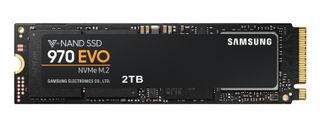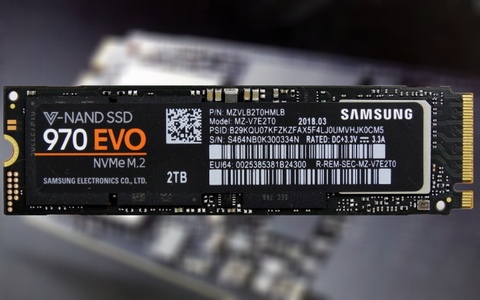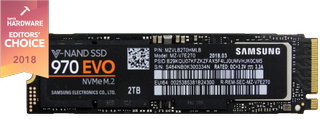Tom's Hardware Verdict
The 970 EVO 500GB matches the SMI SM2262 512GB SSDs in performance, but it also brings a longer warranty, a great software package, and a massive endurance increase. Pricing is more competitive here, but you are not going to store many games on this one.
Pros
- +
Strong performance
- +
Excellent software package
- +
Class-leading endurance
Cons
- -
High pricing at launch
Why you can trust Tom's Hardware
Features & Specifications
Update 5/7/2018: We have updated the article with testing of the 512GB and 256GB 970 EVO models. The new models begin on page three.

Samsung's new 970 Series comes with EVO models for the mainstream and Pro models for enthusiasts and professional users. Samsung's latest NVMe SSDs come as the company is facing renewed competition from companies armed with 64-layer flash. In recent months, products from several companies have gained ground on Samsung's once-dominant 960 EVO that comes with 48-layer flash.
Capacities Rated
Behind closed doors at CES, several third-party SSD manufacturers (companies without their own controller or flash production) told us their future products could match Samsung's 960 EVO. These claims crop up every few years as technology improves, but third-party companies usually have a tough time matching Samsung's pricing. The advent of 64-layer flash from several fabs changes that: new third-party SSDs perform as well (if not better) than the two-year-old 960 EVO but cost significantly less.
Samsung has an answer, and it starts with its own 64-layer flash. The 970 EVO features the new flash and the same five-core Phoenix controller as the Pro model. The higher-priced 970 Pro delivers exceptional sustained write performance for advanced workstation-class workloads while the 970 EVO slots in for mainstream applications. The Pro is faster during extended workloads, which largely stems from the type of flash Samsung uses with the two models: The Pro has pricey MLC flash while the EVO uses less-expensive TLC. You can read all about the 970 Pro in our full review here.
Samsung designed the 970 EVO for 99% of us, but is it the SSD that 99% of us should actually buy? We will answer that question today.
The 970 EVO models span from 250GB to 2TB, which sets a new high-capacity watermark for the EVO series. The 2TB's $849.99 price tag will keep most from venturing into this spacious territory, but it's a much-needed addition to the EVO series.
The high-end 2TB model reaches peak read/write throughput of 3,500/2,500 MB/s, while random read/write performance weighs in at 500,000/480,000 IOPS. The 970 EVO SSDs offer differing levels of performance for each capacity point, as listed in the table above. The gaps appear meaningful on paper, but in practice, factors beyond the SSDs' control, such as operating system bottlenecks, minimize the differences. Samsung also spec's its drives with four workers at a queue depth of four (apiece) to extract the most performance, but that's far more stringent than normal desktop applications.
Pricing, Warranty, And Endurance
| 970 Series | EVO 250GB | EVO 500GB | Pro 512GB | EVO 1TB | Pro 1TB | EVO 2TB |
| Price | $119.99 | $229.99 | $329.99 | $449.99 | $629.99 | $849.99 |
| Endurance | 150 TBW | 300 TBW | 600 TBW | 600 TBW | 1,200 TBW | 1,200 TBW |
The 970 EVO starts out at just $119.99 for the 250GB model and spans up to $849.99 for the 2TB. Every drive in the new 970 Series (including the 970 Pro) carries a five-year warranty. The differences between the Pro and EVO series boil down to endurance, cost, and sustained performance.
NVMe SSDs are getting very close to the performance limits of the PCIe 3.0 x4 bus, and other companies have closed the performance gap. Now Samsung is using its endurance advantage as a selling point as shoppers start to look for more value-add features rather than just chart-topping performance. The 970 EVO builds on Samsung's endurance lead and offers 1.5x more endurance than its predecessor.
Intelligent TurboWrite
SSD vendors use SLC-programmed buffers to improve the write performance of TLC SSDs. Samsung introduced the concept of a two-tiered SLC buffer on the 960 EVO and continued the practice with the 970 Series. The EVO's fixed buffer is either 4GB or 6GB depending on the SSDs' capacity. This small buffer absorbs random write traffic and is even sufficient for heavy multitasking workloads.
| Product | EVO 250GB | EVO 500GB | EVO 1TB | EVO 2TB |
| Static Buffer Capacity | 4GB | 4GB | 6GB | 6GB |
| Intelligent TurboWrite Capacity | 9GB | 18GB | 36GB | 72GB |
| Total Capacity | 12GB | 22GB | 42GB | 78GB |
| TurboWrite Performance | 1,500 MB/s | 2,300 MB/s | 2,500 MB/s | 2,500 MB/s |
| Native Flash Performance | 300 MB/s | 600 MB/s | 1,200 MB/s | 1,250 MB/s |
The dynamic Intelligent TurboWrite buffer kicks in when you transfer a large file to the drive and expands if the drive has enough unused space. This also varies by drive capacity, as outlined in the table above. Using the extra performance is difficult unless you are transferring data from a high-speed device or over a fully-saturated 10-gigabit Ethernet network.
The 970 EVO comes armed with the new five-core Phoenix controller that dedicates one core to communication with the host PC via the NVMe 1.3 interface. We tested the Phoenix controller after acquiring a pair of SSDs released to the system builder market. We still don't know a lot of details about the new eight-channel controller even though Samsung uses it in several new products that range from the PM981 to its enterprise-class products.
Samsung's 64-layer V-NAND flash increases raw performance while also reducing power consumption. Samsung's 64-layer flash has already made an appearance in the Portable T5 SSD that we tested in late 2017 and the 860 EVO from early 2018. The new 2TB EVO has a new 512Gbit die that is twice as large as the 256Gbit die. To our knowledge, this is the first retail SSD to use the denser die.
Features
The 970 EVO supports Microsoft's eDrive and TCG Opal 2.0. eDrive is an encryption feature found on Windows 8, 8.1, and 10. Businesses often use TCG Opal to secure notebooks and desktops because it provides remote administration features.
![[766779 - Thermal_Performance] Chart Provided By Samsung](https://cdn.mos.cms.futurecdn.net/s49nQzV3KMqPVJmGq4gGFb-320-80.jpg)
The new Phoenix controller has a nickel cover that aids in thermal dissipation. Samsung also carried over the thin copper strip on the back of the drive from the 960 EVO. The strip wicks heat through the circuit board and away from the controller. The improved thermal performance allows the drive to transfer more data before the Dynamic Thermal Guard (thermal throttling) kicks in. Samsung tells us the 970 EVO's trigger point comes 12 seconds later than it did with the 960 EVO, thus allowing you to transfer 26% more sequential data at maximum throughput.
The improved cooling, controller, and flash also offer increased sustained random performance. Samsung says the EVO boosts sustained random write performance by 27% over the previous-gen model. It also provides better performance consistency.
Software
Samsung's next Magician and Data Migration Software release will support the 970 Series. Magician allows you to view SMART information, test the drives with a load generator (benchmark), secure erase the drive, and update the firmware. The Data Migration Software speeds your migration to the new SSD by allowing you to clone data from an existing drive.
Samsung also released a its new NVMe Driver 3.0, which is a step forward from the 2.3 version. In the past, Samsung's NVMe driver has increased performance in random workloads. This time, the company is very vague about the details:
Together with the 970 EVO, Samsung is launching the Samsung NVMe Driver 3.0, which amidst a hugely diverse ecosystem for NVMe technology, is designed for maximal compatibility between the user’s system resources and the Samsung 970 EVO NVMe SSD. For example, through the use of the Samsung NVMe Driver 3.0, it becomes possible to operate the 970 EVO with Windows 7.
The new 3.0 NVMe driver will become an important topic later in this review when we look at the performance results.
Packaging


Samsung uses its standard color scheme for the 970 Series' packaging. Samsung lists the five-year warranty period on the package, but it doesn't list any performance or endurance specifications. The fine print points you to the Samsung website for more information.
A Closer Look






All 970 Series drives have the same hardware layout. The PCB has just two flash packages, a single DRAM package, and a nickel-coated Phoenix controller. To the naked eye, it appears that Samsung uses a thicker copper strip on the back of the drive than it did with the 960 Series.
MORE: Best SSDs
MORE: How We Test HDDs And SSDs
MORE: All SSD Content
-
WINTERLORD id assume if you already have a 960 evo, then its not yet worth the upgrade meaning you wouldnt notice a difference in real world performance?Reply -
rinosaur So whats next? PCI x8? I just got a SM2262 drive and it outbenches my old SATA SSD 5 times over but I can't really tell even on boot up. I wish there was a Battlefield 1 benchmark since BF3 is pretty old and the maps will be tiny in comparison. At the same time I don't know what the bottleneck is when loading multiplayer maps. Even small games like HotS could not possibly be utilizing the old 500MB/s drive to the max since it takes like 15 seconds to get to 100% with low CPU/memory usage.Reply -
Co BIY In the Application Storage Bandwidth chart the Samsung 970 EVO is mislabeled as a Plextor product.Reply -
modeonoff I cannot find it in major online stores in North America yet. Don't know about availability. When it becomes available, will the current SSD prices drop?Reply -
ATI9800Pro Where can I get that Plextor 970 EVO 2TB in the Application Storage Bandwidth chart ? :DReply -
mikeynavy1976 Similar question to ERN88. I currently have a 850 EVO (M.2) in a desktop (i7-7700k w/ 16GB RAM) and I don't notice any real world difference from a Dell XPS 13 w/ older NVMe drive. Benchmarks, obviously, show the NVMe considerable faster. Is it still only worth upgrading from SATA to NVMe (SSD of course) with specific workloads?Reply -
Darkbreeze I wouldn't exactly call the MX500's read/write speeds of 560/510 MB/s and 95/90k IOPS "catching up". It surprised me when I read that so I went to double check. The MX500 is not even as fast as the 960 EVO (Actually, it's less than half as fast) much less the 970, and it's more expensive, at 121.99 being the least expensive I could find one for, although the double storage space is nice, users looking for fast drives are more worried about performance than they are about doubling the capacity of a much slower drive.Reply
Unless you can show conclusive performance versus pricing, with links, I'm afraid I can't agree with the validity of some of the information shown here.




